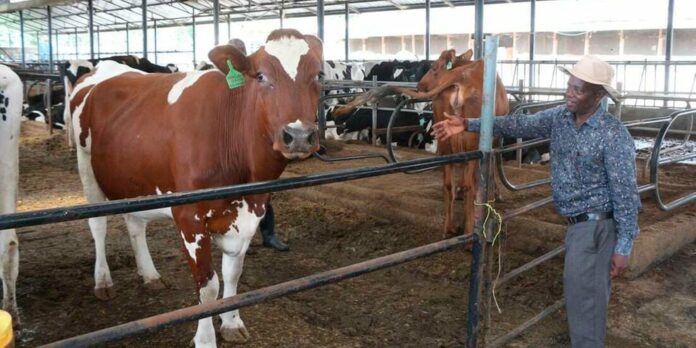Francis Mwangi is the owner of the high prosperous Joy Farm that is located in Lanet, Nakuru County. At this farm, Mr. Mwangi mainly keeps Friesian and Ayrshire animals mainly.
He recently revealed to a local agribusiness journal that he has 100 cows, 32 of which he is milking. The rest of the herd comprises of 10 dry cows, 25 in-calf heifers, seven calves and 26 heifers
His farm, which is made up of five-acres, also hosts lucerne and maize fodder plantations as well as a barn and a servant quarters.
“I grew up with livestock and loved the idea of keeping them. My parents kept a single cow we called January, which we milked as we grew up,” he said.
In a media interview, Mwangi said that in 2000, he actualized his dream of starting a dairy farm by buying two cows, but closed the unit in 2004 after he was transferred from Nakuru to Nandi.
Mwangi started the business again in early 2006 with a single cow but as fate would have it, it died from disease. The same year, he moved from his quarter acre to five that he had purchased after he was transferred back to Nakuru.
Anna Ndunda: How my chickens give me 43 trays of eggs every day
In 2008, he bought four Friesian cows from a farmer who was disposing them and nurtured them. He spent Sh. 50,000 on the herd
“From a litre of milk that they were each giving, they moved to five, then 10 and 15 in three months,” he told local agribusiness journal Seeds of Gold in a previous interview.
He then bought three more and soon, his herd increased to 15. He sold the bull calves as soon as they were born to save on the cost of rearing them.
He expanded his dairy herd to 24, then to 55 after building a 64 by 40 feet modular cow barn. He currently hosts his 100 cows in a 40 by 128 feet barn.
The livestock stays in the barn in seven groups, starting with the calves, weaners, heifers, bullying heifers, in-calf heifers, dry cows and milkers. The daily routine at the farm starts at 4am. The farm has seven employees who start off by cleaning, milking and feeding the animals.
“For milkers, we feed them maize silage, hay and lucerne in the ratio of 70, 15 and 15 per cent respectively. The feeding depends on the stage, with the milkers getting more silage while heifers do with hay alone,” said Mwangi.
The animals are also given dairy meal that they formulate on the farm depending on the amount of milk they produce. Their highest milker offers 42 litres a day while the lowest 14 .
The cows are milked using machines thrice a day at an interval of eight hours and then the produce is stored in a cooler before it is collected by a processor from Nairobi.
“We collect 750 litres of milk daily and sell each at Sh. 54. Keeping in the cooler enables us to get better prices and avoid spoilage,” said Mwangi.
He owns two coolers, one that is 3,000 litre and the other 1,100 . Having the coolers, making his own feeds as well as growing fodder has helped not only to cut costs but also make the farm profitable.
“We use several ingredients to make the dairy meal. They include maize, maize germ, wheat bran, canola, meal, soya meal, lime, salt, toxin binder, bi-carbonate of soda and dairy premix,” he said.
To curb pest pests and diseases, they spray the animals twice a month and deworm the calves and weaners once a month. Mwangi added that he vaccinates his cows twice a year against foot and mouth and lumpy skin diseases, which killed his two animals in 2019.
Training is key, he says, noting he attends workshops hosted by institutions like SNV Netherlands to learn new skills.
“One of the lessons I have learnt from the venture is that you cannot keep few cows and operate optimally. Economies of scale help, but it takes time to achieve that. In my case, it took me about a decade.”
Mwangi says that one of the challenges in the business is fluctuating milks prices. “The cost of running a dairy business is high but you can cushion yourself by planting maize for silage and growing fodder like lucerne. These are the small things make the difference,” said Mwangi. His target in three years is to milk over 100 cows, getting an average of 25 litres from each.








